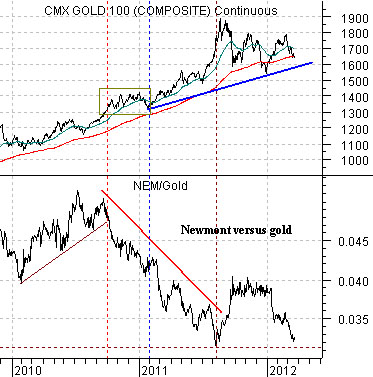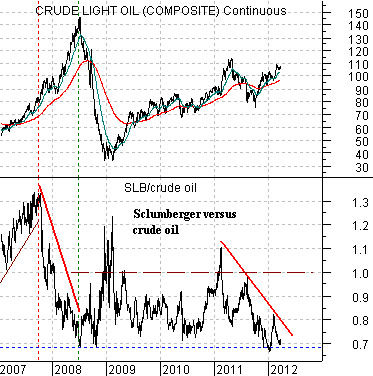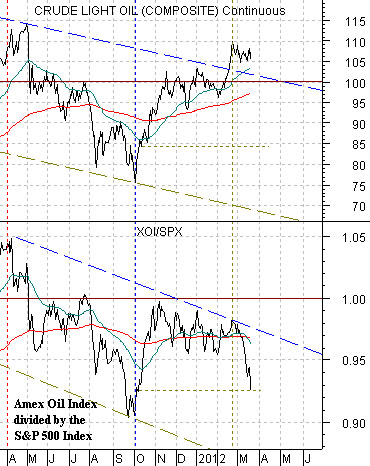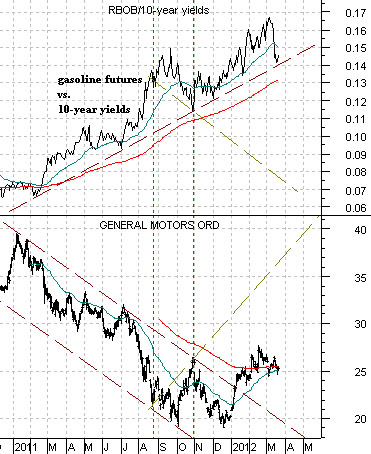Something is definitely askew within the markets. We imagine that those bullish on the gold miners or the oil stocks must be somewhat confused with the relative action over the past year or so.
Just below is our comparison between gold futures prices and the ratio between the share price of gold miner Newmont (NEM) and gold.
Back in 2010 as gold prices began to push up to and then through the 1400 level the ratio between Newmont and gold started to decline. There are, perhaps, two ways to view this divergence.
First, any price of gold above 1300- 1400 is ‘too high’. Weakness in the gold mining stocks suggests that the markets do not believe that gold will remain north of 1400 over the longer run.
Second, the equity markets are far ‘too low’. If investors come to believe that gold prices are going to remain at current levels then over time the gold mining stock prices will rise to reflect the new reality.
Next is a comparison between crude oil futures and the ratio between the share price of oil service company Schlumberger (SLB) and crude oil.
In our opinion… the equity markets ‘lead’. If the oil stocks are strong and rising then oil prices should follow. And vice versa.
Notice that the SLB/crude oil ratio turned lower in the autumn of 2007. The stock market was ‘saying’ that growth was slowing even as oil prices powered higher. Eventually the price of crude oil collapsed sending the SLB/crude oil ratio back above 1:1. In general our view is that when the price of SLB rises above the price of crude oil the trend for crude has turned back to positive.
The two points that we wished to make once again are as follows. First, the SLB/crude oil ratio is essentially back to the lowest levels since 2008. If history were to repeat… oil prices should decline.
Second, the 2008 example gives us a ‘lean’ with regard to the divergence between gold and the gold mining stocks. Our expectation is that the divergence should be resolved through falling gold prices instead of strength in the gold miners.


Equity/Bond Markets
Our sense is that the rising trend for the equity markets has stalled somewhat as we await some kind of resolution with respect to crude oil futures prices.
The view would be that for the S&P 500 Index to resolve higher we are going to need to see either much stronger oil prices or, conversely, much weaker oil prices.
Now… let’s see if we can actually explain our point.
Below is our comparison between crude oil futures and the ratio between the Amex Oil Index (XOI) and the S&P 500 Index (SPX).
The argument is that as soon as crude oil prices hit 110 and then started to flatten out… the XOI/SPX ratio began to decline. In other words money that had moved into or remained in the oil stocks started to head for the exits almost the minute that crude oil prices reached a peak.
The oil stocks represent a fairly heavy weighting within the S&P 500 Index (third largest sector weighting somewhere close to 13% if memory serves) so absolute price declines are putting pressure on the broad market.
We have argued that the energy price trend actually turned bearish back around the end of the first quarter in 2011. From that point forward the XOI/SPX ratio has moved lower. The problem is that crude oil ‘prices’ have remained quite strong.
Another view is that an XOI/SPX ratio above 1:1 supports crude oil futures prices north of 100. Such was the case in the spring of last year but that is most certainly not the case at present. The XOI/SPX ratio stalled just below 1:1 as crude oil prices moved up to 100 in the final quarter of last year but recent weakness in the ratio suggests that crude oil would be ‘better’ around 85 instead of holding flat between 105 and 110.
So… the stock market might benefit from rising oil prices through a return to a more bullish trend for the major oil stocks. Fair enough.
Another alternative would be for energy prices- especially gasoline futures- to break significantly lower. To the extent that rising gasoline prices are a tax on consumption this might be viewed in a positive light by the equity markets.
At bottom is a comparative view of General Motors (GM) and the ratio between gasoline futures (RBOB) and 10-year Treasury yields.
The argument has been that the energy ‘users’ (i.e. GM) would benefit from one of two outcomes. Either a return to rising long-term Treasury yields (suggesting the kind of improving cyclical strength that helps economically sensitive sectors) or falling gasoline prices.
The gasoline/yields ratio makes the fairly simple point that lower energy prices would be a positive unless… the decline in energy prices is caused by the kind of demand destruction that goes with tumbling long-term interest rates. So the best case for the oil stocks would be rising oil prices while the preferred outcome for the autos and airlines would be declining energy prices with flat to rising yields.





